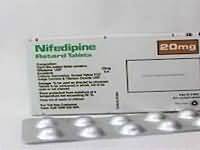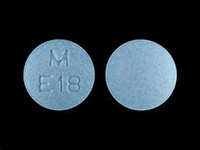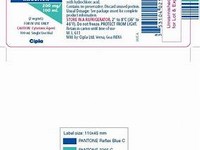nifedipine

CLINICAL USE
Calcium-channel blocker:Prophylaxis and treatment of angina Hypertension Raynaud’s phenomenon
DOSE IN NORMAL RENAL FUNCTION
Capsules: 5–20 mg 3 times dailyTablets: 20–40 mg twice dailyMR: 20–90 mg daily
PHARMACOKINETICS
Molecular weight :346.3 %Protein binding :92–98 %Excreted unchanged in urine : <1 Volume of distribution (L/kg) :1.4half-life – normal/ESRD (hrs) :1.4–11 (depends on preparation)/Unchanged DOSE IN RENAL IMPAIRMENT
GFR (mL/MIN)
20 to 50 : Dose as in normal renal function 10 to 20 : Dose as in normal renal function. Start with small doses <10 : Dose as in normal renal function. Start with small doses DOSE IN PATIENTS UNDERGOING RENAL REPLACEMENT THERAPIES
CAPD :Not dialysed. Dose as in GFR <10 mL/min HD :Not dialysed. Dose as in GFR <10 mL/min HDF/high flux :Unknown dialysability. Dose as in GFR <10 mL/min CAV/VVHD :Unknown dialysability. Dose as in GFR 10 to 20 mL/min IMPORTANT DRUG INTERACTIONS
Potentially hazardous interactions with other drugs Anaesthetics: enhanced hypotensive effect Antibacterials: metabolism accelerated by rifampicin; concentration increased by quinupristin/dalfopristinAnti-epileptics: effect reduced by carbamazepine, barbiturates, phenytoin and primidone Antifungals: metabolism possibly inhibited by itraconazole and ketoconazoleAntihypertensives: enhanced hypotensive effect, increased risk of first dose hypotensive effect of post-synaptic alpha-blockers; occasionally severe hypotension and heart failure with beta-blockersAntivirals: concentration possibly increased by ritonavirCardiac glycosides: digoxin concentration possibly increasedCiclosporin: may increase ciclosporin level, but not a problem in practice; nifedipine concentration may be increased Grapefruit juice: concentration increased – avoid concomitant useInsulin: may impair glucose tolerance Magnesium salts: profound hypotension with IV magnesium Tacrolimus: increased tacrolimus levels Theophylline: possibly increased theophylline concentration ADMINISTRATION
Reconstition
– Route
Oral Rate of Administration
–Comments
– OTHER INFORMATION
Protein binding decreased in severe renal impairmentAcute renal dysfunction reported Increased incidence of side effects (headache, flushing, dizziness and peripheral oedema) in patients with ERFFor acute use, bite capsule then swallow contents with 10–50 mL water.
See how to identify renal failure stages according to GFR calculation
See how to diagnose irreversible renal disease
Home









